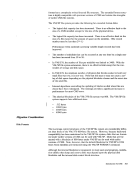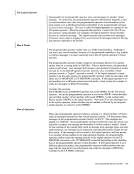See the VM / SP CMS Command and Macro Reference for information on how to
use file system macros with the extended file system. See the VM /SP System Logic
and Problem Determination Guide, Volume 2, to learn about the structure of the
VM/SP file system.
Programs That ReferenceSystem Information
Existing programs that reference internal CMS file system control information will
probably·not function correctly under VM/SP.
Note: Unconverted programs that run with the SYSTEM attribute (privileged) or
do directI/O (DIAGNOSE) can destroy data on (or the logical structure of) a
minidisk, making part or all of the data on that minidisk inaccessible.
Before running them on VM/SP examine any programs that perform functions sim
ilar to the TAPE and DISK commands, programs that copy files, programs that
copy minidisks, and programs that are used to dump and restore files for backup.
Areas to be examined include:• The format of the File Status Table (FST) has been changed in several ways
including its length. Programs that reference FST copies returned by the
STATE command or FSST ATE/FSOPEN macros continue to function
because new format FSTs are converted to old formats in the copy returned to
the user.
Programs that reference fields in real FSTs (those in the FST hyperblocks or
AFTs) may not function properly. Programs that change fields in FSTs can
destroy the integrity of the file system.
Note that careful evaluation of both the program and CMS file system internal
processes may be necessary to determine what must be done with such pro
grams.• The format and contents of the Active File Table (AFT) control block have
been significantly changed for extended format disks. The order of fields in
the AFT for800-byte block disks has been changed. Programs referencing the
AFT should be carefully examined and must at least be reassembled before
running them even with800-byte format disks.
The format of the Active Disk Table (ADT) has been significantly altered.
Many fields with new meaning have been added, and many existing fields have
been relocated.One such field is the disk volume label VOLID, which has
moved.• The format of most other VM/370 file system control information is different
from the VM/SP format file system. Programs that reference such data should
be carefully examined and altered before running them.
Programs that install auxiliary directories by changing the SST AT field inNUCON will not function properly if the S-disk is an extended format disk.
The CMS routine DMSLADAD should be used to install all auxiliary directo
ries.
All programs that referenceVM/370 CMS control block macros should be
reassembled under VM/SP. If the only control block referenced isNUCON, Introduction To eMS 307
use file system macros with the extended file system. See the VM /
and Problem Determination Guide, Volume 2, to learn about the structure of the
VM/SP file system.
Programs That Reference
Existing programs that reference internal CMS file system control information will
probably
Note: Unconverted programs that run with the SYSTEM attribute (privileged) or
do direct
minidisk, making part or all of the data on that minidisk inaccessible.
Before running them on VM/SP examine any programs that perform functions sim
ilar to the TAPE and DISK commands, programs that copy files, programs that
copy minidisks, and programs that are used to dump and restore files for backup.
Areas to be examined include:
including its length. Programs that reference FST copies returned by the
STATE command or FSST ATE/FSOPEN macros continue to function
because new format FSTs are converted to old formats in the copy returned to
the user.
Programs that reference fields in real FSTs (those in the FST hyperblocks or
AFTs) may not function properly. Programs that change fields in FSTs can
destroy the integrity of the file system.
Note that careful evaluation of both the program and CMS file system internal
processes may be necessary to determine what must be done with such pro
grams.
been significantly changed for extended format disks. The order of fields in
the AFT for
AFT should be carefully examined and must at least be reassembled before
running them even with
The format of the Active Disk Table (ADT) has been significantly altered.
Many fields with new meaning have been added, and many existing fields have
been relocated.
moved.
from the VM/SP format file system. Programs that reference such data should
be carefully examined and altered before running them.
Programs that install auxiliary directories by changing the SST AT field in
The CMS routine DMSLADAD should be used to install all auxiliary directo
ries.
All programs that reference
reassembled under VM/SP. If the only control block referenced is



































































































































































































































































































































































































































































































































































































































